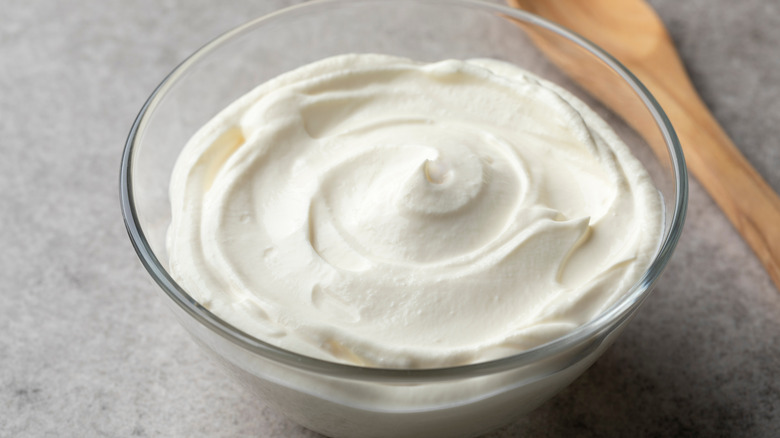What Is Creme Fraiche And How Is It Different From Sour Cream?
Have you ever found yourself in the dairy section of the grocery store coming face to face with both sour creme and crème fraîche and wondering how they're different? Better yet, have you ever had a recipe call for crème fraîche and wondered if you can just use sour cream instead? While most Westerners are well acquainted with sour cream, there's a bit more mystery behind crème fraîche. What is crème fraîche? And how is it both similar to and more unique than sour cream?
Crème fraîche is a cultured cream that comes from France and has a thick consistency. Its flavor is tangy and sour, with a bit of sweetness that might be described as nutty. Typically, crème fraîche has a fat content of around 30%, which is much higher than most sour creams. While it is tangy, it's still a bit less sour than sour cream. If you sweeten it, it works well in desserts. In that way, it's got a flavor profile that's closer to that of cream cheese.
Sour cream is also a cultured cream that has origins in Eastern Europe. It has a bit more of a watery texture than crème fraîche, and its sour flavor is more pronounced. While there are lower-fat options for sour cream, they often use ingredients such as gelatin or rennet to stabilize them, so they're not as authentic as a full-fat sour cream.
How sour cream is different
While sour cream and crème fraîche are similar, there are some differences that affect their flavor, texture, and how they're used. Most full-fat sour cream has about 20% fat, with the lower-fat options having closer to 18% — far lower than the 30% fat you'll find in crème fraîche.
Sour cream has less fat than crème fraîche; it's also a bit tangier and more watery. When considering which to use, it's important to consider what you need from the ingredient and how you're preparing them. Let's say you're using one or the other to top a dish like a baked potato. If you're looking for a thicker consistency or higher fat content and you don't need an abundance of zesty tang, go ahead and use crème fraîche. This would be a perfect use if you were dressing a baked potato but had no butter on hand. You'll still get that great zippy flavor and a bit of extra milk fat in the crème fraîche.
However, if you're looking for more of an intensely tangy flavor and you're not as considered with fat content, then opt for sour cream. In a pinch? You really could use the two interchangeably. But there are considerations to be made if you're cooking or baking with these ingredients.
What crème fraîche really is
Beside the fact that sour cream has a lower fat content than crème fraîche, it has more protein than crème fraîche. And the protein it contains can affect its consistency when you add heat to it.
Sour cream is far more likely to curdle when heated, which is one of the reasons why it's most often used as a condiment or last-minute addition to a hot dish. If you have a cooking or baking recipe that calls for sour cream, make sure you follow the instructions closely, in case you have to temper the sour cream. Crème fraîche, on the other hand, is a much more stable ingredient. You can easily add it to soups, stews, gratins, or even sauces without worrying that it will separate or curdle.
In baked goods, the higher acidity of sour cream can work against the gluten structures of your baked goods. If you're looking for something that's more moist, this can be a good thing. But if your recipe calls specifically for crème fraîche, you may want to get that instead.



